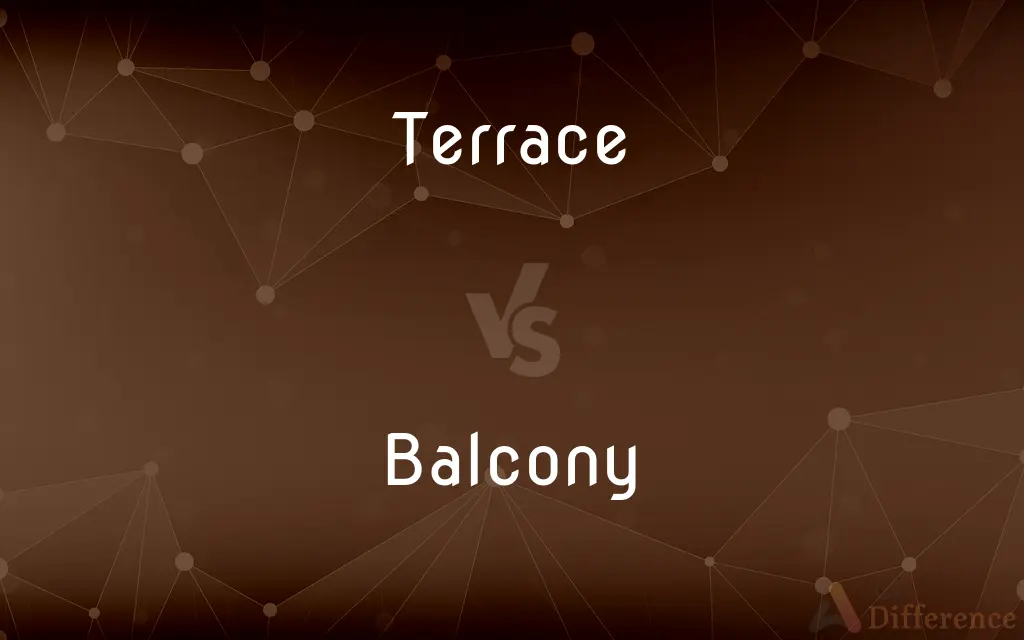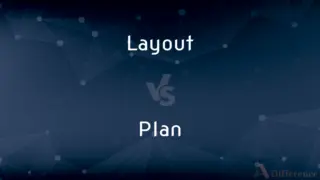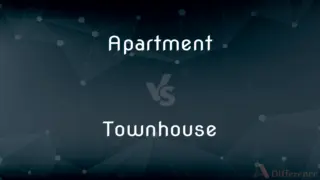Terrace vs. Balcony — What's the Difference?
By Tayyaba Rehman — Updated on October 29, 2023
A terrace is a flat, open outdoor space, often at ground level or on a building's roof, while a balcony is a platform projecting from the wall of a building, enclosed by a railing or balustrade.

Difference Between Terrace and Balcony
Table of Contents
ADVERTISEMENT
Key Differences
Terraces are outdoor platforms that can be found at ground level or on top of buildings, offering a wide, open area for leisure or gardening. A balcony, typically smaller than a terrace, protrudes from the side of a building, providing an elevated outdoor space.
A terrace may be an extended part of the building's architecture or a landscaped feature of gardens, often spacious enough to host gatherings. Balconies, on the other hand, are usually designed for small-scale enjoyment, such as having a coffee or reading a book, due to their limited space.
Terraces can serve as additional green spaces in urban environments, where residents can create gardens or relaxation spots. Conversely, balconies are often seen as personal retreats from the confines of indoor living, a private space to enjoy the outdoors and view.
In terms of real estate, a terrace, especially a rooftop one, can significantly increase the value of a property by offering versatile outdoor space. Balconies add value too, but they are more for the private use of the occupants, often accessed from a bedroom or living room.
While a terrace might be covered by pergolas or awnings for shade, it is generally more exposed to the elements than a balcony, which can be partly enclosed or overshadowed by the building's structure. Balconies can also be more decorative, contributing to the building's façade.
ADVERTISEMENT
Comparison Chart
Location
Ground level, atop a building, or between two stories of a building
Projecting from the wall of a building, typically above ground level
Size
Usually larger and can extend over a greater area
Generally smaller and designed for individual or small group use
Structure
Flat platform, often without a roof; can be open or landscaped
Elevated platform with a railing, often with a roof overhead
Purpose
For recreation, gardening, or as a communal space
For private enjoyment, offering a view and fresh air
Architectural Feature
May affect the overall design and structure of a building
Usually a secondary feature, not altering the building's structure
Compare with Definitions
Terrace
A flat paved or earthen area adjoining a building.
They hosted a barbecue on the terrace.
Balcony
A platform enclosed by a wall or balustrade on the outside of a building, with access from an upper-floor window or door.
He stepped out onto the balcony to admire the sunset.
Terrace
A level paved area or platform next to a building; a patio.
Guests mingled on the terrace during the cocktail hour.
Balcony
A gallery in a theater or auditorium.
The audience in the balcony gave a standing ovation.
Terrace
A level paved area next to a building; a patio
Breakfast is served on the terrace
Balcony
A projecting platform on a building's exterior wall, often with a decorative railing.
Juliet stood on the balcony, waiting for Romeo's serenade.
Terrace
Each of a series of flat areas made on a slope, used for cultivation.
Balcony
A projecting gallery in a public building or assembly hall.
The speaker looked up to address the people in the balcony.
Terrace
A row of houses built in one block in a uniform style
An attractive Regency terrace
Balcony
An elevated platform projecting from the side of a building.
Their room had a private balcony with ocean views.
Terrace
Make or form (sloping land) into a number of level flat areas resembling a series of steps
The slope had to be terraced
Balcony
A balcony (from Italian: balcone, "scaffold") is a platform projecting from the wall of a building, supported by columns or console brackets, and enclosed with a balustrade, usually above the ground floor.
Terrace
A porch or walkway bordered by colonnades.
Balcony
A platform that projects from the wall of a building and is surrounded by a railing, balustrade, or parapet.
Terrace
A platform extending outdoors from a floor of a house or apartment building.
Balcony
A gallery that projects over the main floor in a theater or auditorium.
Terrace
An open, often paved area adjacent to a house serving as an outdoor living space; a patio.
Balcony
(architectural element) An accessible structure extending from a building, especially outside a window.
Terrace
A raised bank of earth having vertical or sloping sides and a flat top
Turning a hillside into a series of ascending terraces for farming.
Balcony
An accessible structure overlooking a stage or the like.
Terrace
A flat, narrow stretch of ground, often having a steep slope facing a river, lake, or sea.
Balcony
A platform projecting from the wall of a building, usually resting on brackets or consoles, and inclosed by a parapet; as, a balcony in front of a window. Also, a projecting gallery in places of amusement; as, the balcony in a theater.
Terrace
A row of buildings erected on raised ground or on a sloping site.
Balcony
A projecting gallery once common at the stern of large ships.
Terrace
A section of row houses.
Balcony
An upper floor projecting from the rear over the main floor in an auditorium
Terrace
Abbr. Ter. or Terr. A residential street, especially along the top or slope of a hill.
Balcony
A platform projecting from the wall of a building and surrounded by a balustrade or railing or parapet
Terrace
A narrow strip of landscaped earth in the middle of a street.
Terrace
To provide (a house, for example) with a terrace or terraces.
Terrace
To form (a hillside or sloping lawn, for example) into terraces.
Terrace
A flat open area on the topmost floor of a building or apartment
Terrace
A platform that extends outwards from a building.
Terrace
(agriculture) A raised, flat-topped bank of earth with sloping sides, especially one of a series for farming or leisure; a similar natural area of ground, often next to a river.
Terrace
(geology) A step-like landform; (sometimes) remnants of floodplains.
Terrace
A row of residential houses with no gaps between them; a group of row houses.
Terrace
A single house in such a group.
Terrace
The standing area of a sports stadium.
Terrace
The roof of a building, especially if accessible to the residents. Often used for drying laundry, sun-drying foodstuffs, exercise, or sleeping outdoors in hot weather.
Terrace
To provide something with a terrace.
Terrace
To form something into a terrace.
Terrace
A raised level space, shelf, or platform of earth, supported on one or more sides by a wall, a bank of tuft, or the like, whether designed for use or pleasure.
Terrace
A balcony, especially a large and uncovered one.
Terrace
A flat roof to a house; as, the buildings of the Oriental nations are covered with terraces.
Terrace
A street, or a row of houses, on a bank or the side of a hill; hence, any street, or row of houses.
Terrace
A level plain, usually with a steep front, bordering a river, a lake, or sometimes the sea.
Terrace
To form into a terrace or terraces; to furnish with a terrace or terraces, as, to terrace a garden, or a building.
Clermont's terraced height, and Esher's groves.
Terrace
Usually paved outdoor area adjoining a residence
Terrace
A level shelf of land interrupting a declivity (with steep slopes above and below)
Terrace
A row of houses built in a similar style and having common dividing walls (or the street on which they face);
Grosvenor Terrace
Terrace
Provide (a house) with a terrace;
We terrassed the country house
Terrace
Make into terraces as for cultivation;
The Incas terraced their mountainous land
Terrace
A platform built on the rooftop of a building.
The penthouse boasted a spacious rooftop terrace.
Terrace
A row of houses or apartments on the same level and style.
She lives in a Victorian terrace in the historic district.
Terrace
A piece of sloped plane that has been cut into a series of successively receding flat surfaces or platforms.
The rice terraces are a breathtaking sight.
Common Curiosities
What defines a terrace?
A terrace is a flat, open area, either at ground level or on a building's roof, often used for outdoor living spaces.
What is a balcony?
A balcony is a small platform projecting from the wall of a building, enclosed by railings, and accessible from an upper-floor window or door.
Are balconies private or communal?
Balconies are typically private spaces for the building's occupants.
Is a terrace the same as a patio?
A terrace is similar to a patio but can be elevated or on a roof, while patios are always on the ground.
Can terraces be found on any level of a building?
Yes, terraces can be at ground level, in between floors, or on the roof of a building.
Can a balcony have a garden?
Yes, balconies can host small gardens, often with container plants.
Are terraces common in apartment buildings?
Yes, especially in urban areas where outdoor space is valued.
Do all buildings with terraces have flat roofs?
Not necessarily, but terraces are more common on buildings with flat roofs.
Are balconies always outdoors?
Yes, balconies are outdoor spaces.
Can terraces be enclosed?
Terraces are typically open, but they can be partially enclosed with pergolas or screens.
What safety features are common for balconies?
Railings or balustrades are essential for safety on balconies.
Is it possible to barbecue on a balcony?
It depends on the building's rules and safety regulations.
What materials are terraces made from?
Terraces can be made from a variety of materials, including wood, stone, concrete, or tiles.
Can anyone access a terrace in a residential building?
Access depends on the building's design; some terraces are communal, while others are private.
How does a balcony add to a building's design?
A balcony can add aesthetic value and architectural interest to a building's façade.
Share Your Discovery

Previous Comparison
Layout vs. Plan
Next Comparison
Apartment vs. TownhouseAuthor Spotlight
Written by
Tayyaba RehmanTayyaba Rehman is a distinguished writer, currently serving as a primary contributor to askdifference.com. As a researcher in semantics and etymology, Tayyaba's passion for the complexity of languages and their distinctions has found a perfect home on the platform. Tayyaba delves into the intricacies of language, distinguishing between commonly confused words and phrases, thereby providing clarity for readers worldwide.














































